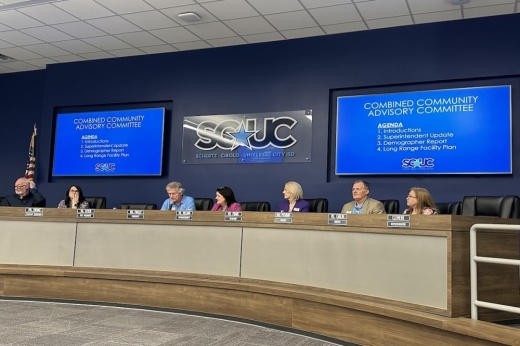Department heads of the district’s operations, athletics, fine arts, Career Technical Education and technology presented longterm project needs during a Community Advisory Committee workshop March 12.
The specifics
Director of Fine Arts Beth Bronk’s presentation focused on needs for Byron P. Steele II and Samuel Clemens high schools, including adding marching band towers for both campuses and repaving the parking lot at Clemens.
Bronk said they also needed band equipment trailers to store theater arts equipment and uniforms, the theater curtain replaced, and refinishing for the auditorium floor at Steele. New band towers to replace the current booster lift, Bronk said, are vital for band leaders to give feedback to different sections.
Athletic Director Scott Lehnhoff said Lehnhoff Stadium needs more separation between spectators, participants and officials; added security fencing; and turf replacement and installation. Lehnhoff said they also need to relocate concessions and the restroom areas at the J. Frank Dobie Junior High stadium, as their current location was noted as a security concern. Much like the fine arts department, Lehnhoff also said they needed a multipurpose activity center with a shaded area to keep student-athletes cool and able to practice.
For specific sports, Lehnhoff brought up the possibility of a dedicated wrestling facility and additional tennis courts at Dobie Junior High.
An additional enhancement at Lehnhoff Stadium is the replacement of a video board and scoreboard, and various concourse improvements. Early estimates for Lehnhoff Stadium totaled $12.52 million, as reported by Community Impact in October, part of an estimated $81.5 million in total athletic improvements.
Out of 16 Career Technology and Education, or CTE, programs, Assistant Superintendent Kelly Kovacs said. Agriculture has the highest enrollment with 1,713 students, and needs started there with updates to the agricultural barn.
Needs at the agriculture barn—used by students at Byron P. Steele II and Samuel Clemens high schools—include fencing, pen replacement, additional heaters and a canopy replacement. Students and animals weren’t the only things the department honed in on at the complex; also asked for added family parking. The CTE department is also thinking about burgeoning industries, asking for a potential esports gaming environment.
Technology Director Steve Barnwell said instructional devices like Chromebooks and iPads reach their useful lifespan typically within six years, necessitating an ongoing replacement schedule.
The department report notes that student device replacements will spike in 2026-27, with 7,285 devices needing to be replaced during that school year. Overall district technology replacements, Community Impact reported in January, would total roughly $6.27 million over the next three years. A similar number of 7,345 student device replacements is pegged for the 2032-33 school year.
The department’s goal is to have devices available so that each student has their own device, looking at enrollment and student schedules to determine a device number threshold which complies with Texas Education Agency recommendations.
Looking ahead
Chief Operations Officer JD Mosley told Community Impact that monetary figures presented by departments are intended solely to give the board of trustees a “general sense of the potential costs associated with early project discussions,” and should not be interpreted as formal funding requests.
Superintendent Paige Meloni said the district is currently accepting proposals from consultants to help with the planning process going into the fall, and that individuals can expect communications on the district's Bond Planning Committee in May or June.





